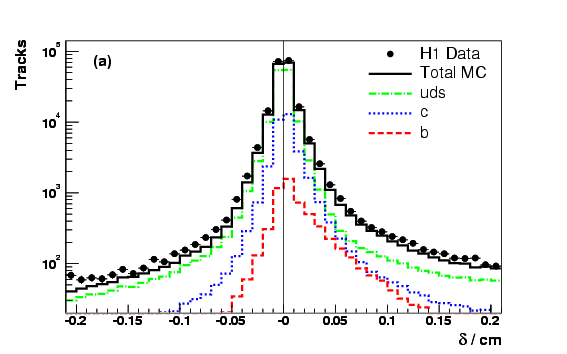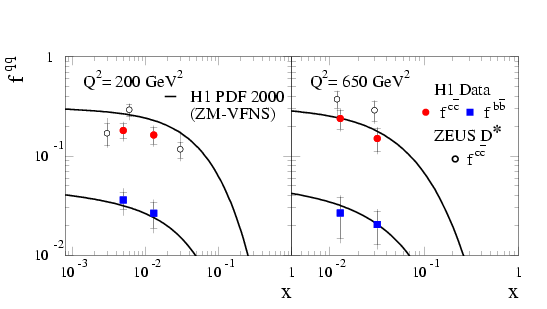
Measurement of F2cc and F2bb at High Q2 using the H1 Vertex Detector at HERA |
Light quarks, the building blocks of ordinary matter, can only stick together to form protons by continuously swapping gluons, which are the particles responsible for carrying the strong force. These gluons can in turn split into quark-antiquark pairs. In addition to pairs of light quarks, heavy quarks, called "charm" (c) and "beauty" (b), can also be produced in these processes. At HERA, the electron beam provides a source of photons with resolving power Q2 that are able to probe the structure of the proton. The rate of collisions in which a c (b) quark is produced provides information on the contribution of c (b) quarks to the proton structure function, called F2cc (F2bb). When Q2 is large the scattering process is called deep inelastic scattering (DIS). The structure function data may be compared with calculations made using the theory of the strong interaction called quantum chromodynamics (QCD). The large masses of the charm and beauty quarks suggest that these calculations should be reliable. The measurement of charm and beauty quarks in DIS therefore provides an important test of our understanding of QCD and the strong interaction.
The strong force of QCD does not allow ``naked'' quarks to be observed, they have to team up with other quarks to produce bound states, called hadrons. In contrast to previous analyses where the production of heavy quarks was identified by looking for specific hadrons, inclusive charm and beauty cross sections, in the range Q2 > 150 GeV2, are measured in this paper. Here events containing heavy quarks are distinguished from light quark events by the fact that the heavy hadrons have a long lifetime which means they travel some way before decaying. This means that tracks from charged particles produced from the heavy hadron decay will be slightly displaced from where the electron and proton beams interact, called the primary vertex. In order to measure the small distances accurate information from the H1 vertex detector, which is located very close to the interaction point, is used. The device can measure track displacements with accuracies down to 3 hundredths of a mm. In the following figure the distance of charged tracks to the primary vertex is shown. The distance is given a sign according to the direction of the track w.r.t. that of the hadronic spray of hadrons, known as a jet, formed from the decay of the quark. For particles coming from light quarks the displacement is zero, within the experimental resolution, leading to a symmetric distribution (green curve). In contrast, particles coming from the decay of heavy hadrons show a positive displacement on average (blue and red curves). This is exploited here to unravel the fraction of events coming from c and b quarks in the data.

In the kinematic range of the measurement, the decays of heavy flavour hadrons are very likely to have a track which passes through the H1 vertex detector. Therefore, the charm and beauty structure functions F2cc and F2bb can be reliably measured. The measurement of F2cc extends H1 measurements to higher Q2 and this is the first ever measurement of F2bb.
The results for F2cc and F2bb are calculated for two values of Q2 and four values of x. Here, x is the fraction of the proton's momentum carried by the heavy quark. The results may also be presented in the form of the contributions to the total production rate (or cross section) of all quarks. These are shown in the figure below. The values of x are small because the heavy quarks are produced from the "sea" of gluons which holds the proton together. It can be seen that the charm quarks contribute around 20% of the total cross section and the beauty quarks around 2%. The results are well described by theoretical predictions based on QCD.

So what did we learn?
The long lifetime of heavy hadrons compared with light hadrons allows the contribution of heavy quarks to the total production rate of all quarks to be reliably measured. The measurements are made possible by the very precise information obtained by the H1 vertex detector. The measurement of the charm structure function F2cc extends H1 measurements to higher Q2 and this is the first ever measurement of the beauty structure function F2bb. The results are seen to be well described by the predictions from quantum chromodynamics, the theory of the strong interaction.